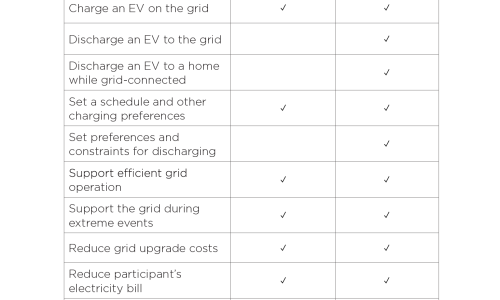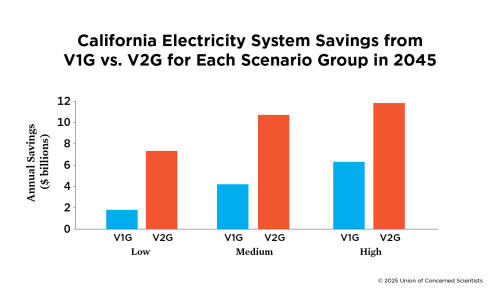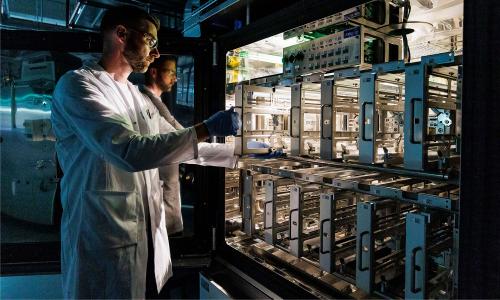A growing transition away from fossil fuel–powered vehicles to electric vehicles (EVs), and toward more renewable energy on its electricity grid, is helping California make critical reductions in air pollution and heat-trapping emissions.
Besides producing no tailpipe emissions, EVs have another benefit: their batteries can act as electricity storage. Vehicle-grid integration (VGI) is the practice of intentionally integrating EVs with the electricity grid through managing the time, rate, or location of charging (V1G) and, in some instances, energy in the battery could be sent to the grid, a process known as V2G.
To better understand the extent to which VGI of light-duty EVs could aid the state’s transition to clean electricity, the Union of Concerned Scientists partnered with Evolved Energy Research to conduct an analysis of different levels of hourly managed V1G and V2G. This analysis shows that VGI enables electricity system savings, ranging from $1.8 billion (1 percent of system costs) to $11.7 billion (5 percent of system costs) per year in 2045. It also found that V2G creates significant incremental benefits over V1G alone.
Harnessing the Power of Electric Vehicles
This is an online version of the executive summary. The full executive summary can be downloaded here
California is on its way to electrifying the cars and trucks on its roads and incorporating more renewable energy on its electricity grid as the state seeks to cut air pollution and heat-trapping emissions. Vehicle-grid integration (VGI) is the practice of intentionally integrating electric vehicles (EVs) with the electric grid through managing the time, rate, or location of charging (V1G) and through allowing EVs to discharge their batteries in parallel with the grid (V2G). Managing charging and discharging can help optimize the use of renewable energy resources, increase efficient use of grid infrastructure, and avoid otherwise necessary---and often costly---grid upgrades. With VGI, drivers support the operation of the grid, and both drivers and the grid can benefit from VGI arrangements (see Table ES-1).
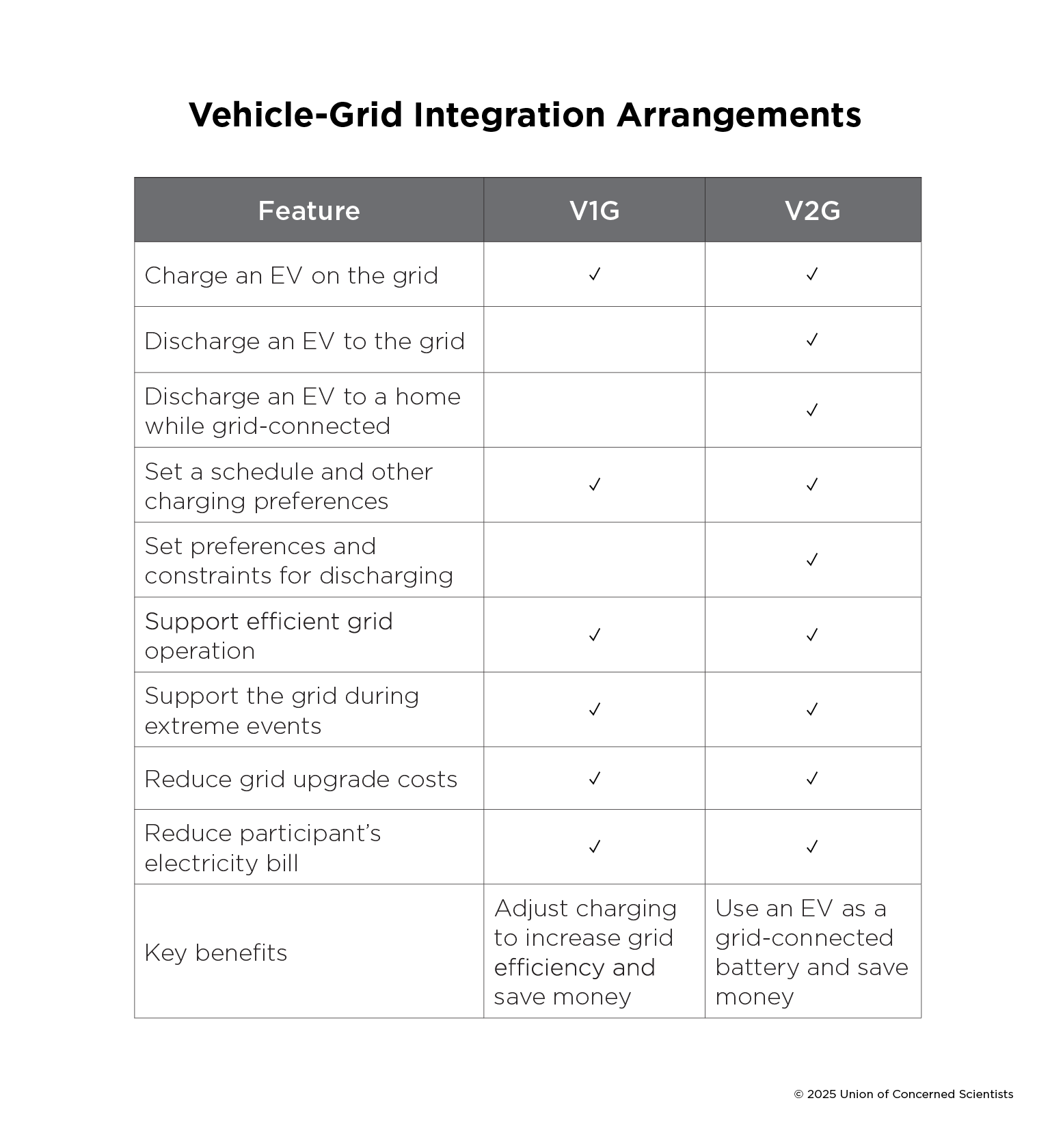
To better understand the extent to which VGI of light-duty EVs could aid California's transition to clean electricity, the Union of Concerned Scientists (UCS) partnered with Evolved Energy Research to conduct an analysis of different levels of hourly managed V1G and V2G. To answer our research questions, we examined three scenario groups (Low, Medium, and High levels of VGI enrollment at Level 2 charging locations) in comparison to a baseline scenario with no VGI. Within each group, we varied the distribution VGI between V1G and V2G. Importantly, the use of EVs for mobility does not change in response to VGI enrollment.
Findings
- VGI enables electricity system savings. Across all scenarios studied, VGI produced annual savings for the electricity system relative to the baseline charging behavior. Savings ranged from $1.8 billion (1 percent of system costs) to $11.7 billion (5 percent of system costs) per year in 2045.
- V2G creates significant incremental benefits over V1G alone. Across all groups, savings increased with participation in V2G. Within each group, the scenario with all V1G had the lowest savings, while the scenario with all V2G had the highest savings (Figure ES-1). V2G created two to four times the savings of V1G, depending on the scenario group.
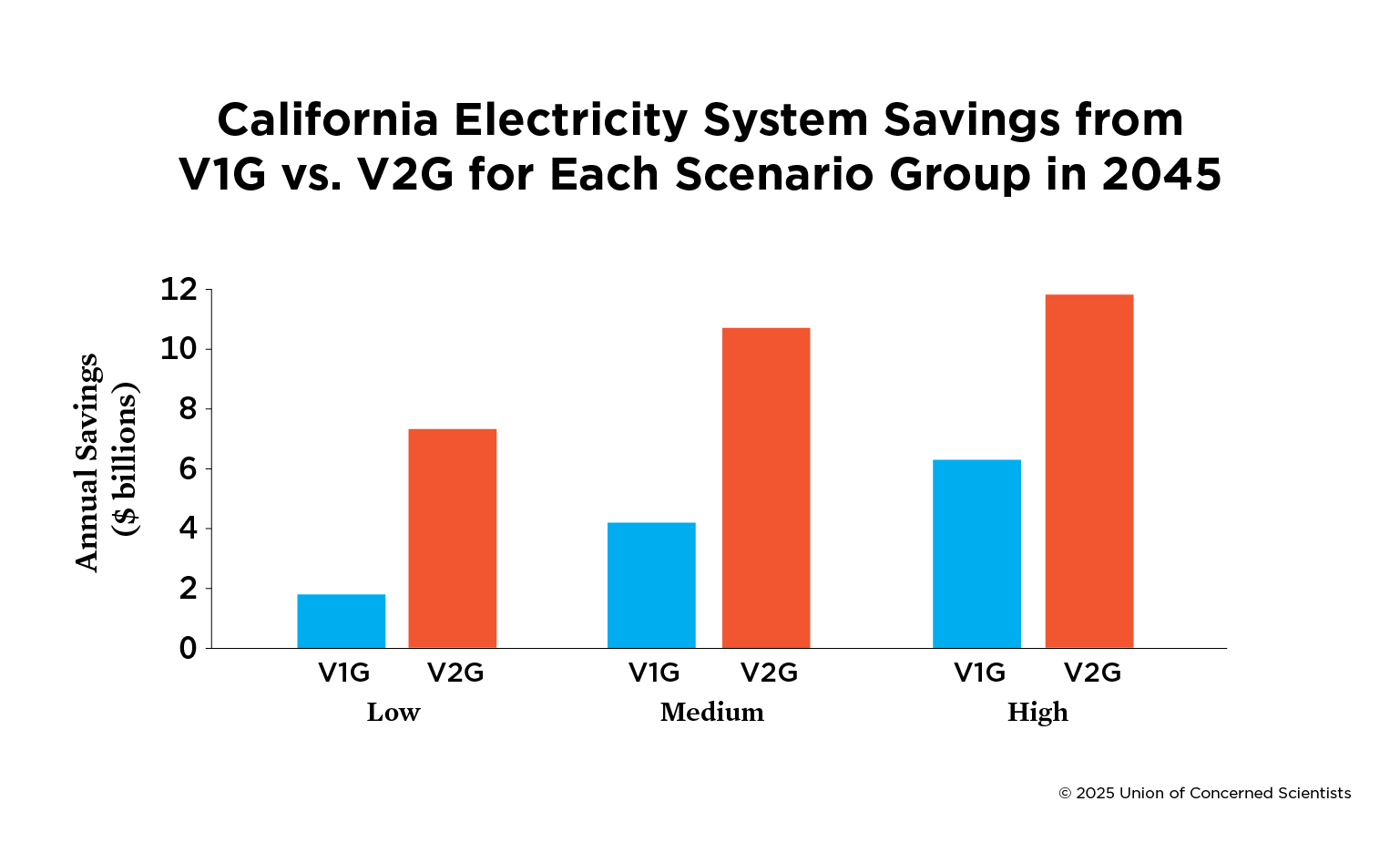
- VGI savings come from the reduced buildout of electricity system infrastructure. VGI reduced electricity delivery costs by reducing peak demand on the distribution system and by better matching electricity demand to variable renewable electricity production. Sources of generation savings included avoided gas generation and bulk energy storage.
- The grid benefits of V2G can be achieved with limited use of EV batteries. In the Medium VGI enrollment scenario with the highest V2G enrollment, we found that, on average, each vehicle in the V2G pool exported power equivalent to driving only an extra 700 miles per year in 2045. That is less than a 7 percent increase in battery use for a vehicle traveling an average of 10,000 miles per year.
- Per-vehicle annual and lifetime VGI savings are significant. Taking the Medium VGI enrollment group as an example again, enrolled vehicles on average generated annual benefits ranging from $503 in the all-V1G case to $1,177 for the all-V2G case in 2045. If these values were accumulated over the average lifetime of a vehicle, the cumulative grid savings per vehicle would range from about $6,000 to about $14,000.
Recommendations
Policymakers, grid operators, and the EV industry should implement the following recommendations to ensure that the California grid can effectively leverage the potential for VGI to benefit all electricity customers:
- Prepare the electricity system and plan on VGI. California agencies should accelerate work on VGI communications protocols, deployment of technologies giving visibility into grid conditions, and incorporation of EVs as a distributed resource in planning.
- Establish systems for efficient interconnection. Regulators must work with grid operators and utilities to increase the efficiency and throughput of EVs in the interconnection queue.
- Support and incentivize drivers. Legislators and regulators should expand support for the upfront cost of VGI equipment at homes and businesses, including comprehensive turnkey installations for low-income households. Regulators and utilities should also work to increase the number and variety of V1G and V2G programs offered to utility customers and grow the participation capacity of those programs.
- Require bidirectional charging capability in vehicles. Regulators should require bidirectional charging capability, including V2G capability in passenger cars and trucks, to ensure drivers have equitable opportunities to participate in V2G as well as use vehicles for backup power.
- Update battery warranty protections to cover discharging. Automakers should allow battery discharging, including V2G, as acceptable use under the warranties for their EVs. When they are making battery warranty requirements, regulators should include a meaningful, clearly defined level of nondriving battery discharge in those requirements.
This is an online version of the executive summary. The full executive summary can be downloaded here
Downloads
Citation
Houston, Sam, David Reichmuth, and Mark Specht. 2025. Harnessing the Power of Electric Vehicles: Integrating Light-Duty EVs with the Grid in California for a Cheaper, More Reliable, Decarbonized Electric System. Cambridge, MA: Union of Concerned Scientists. https://doi.org/10.47923/2025.15888
